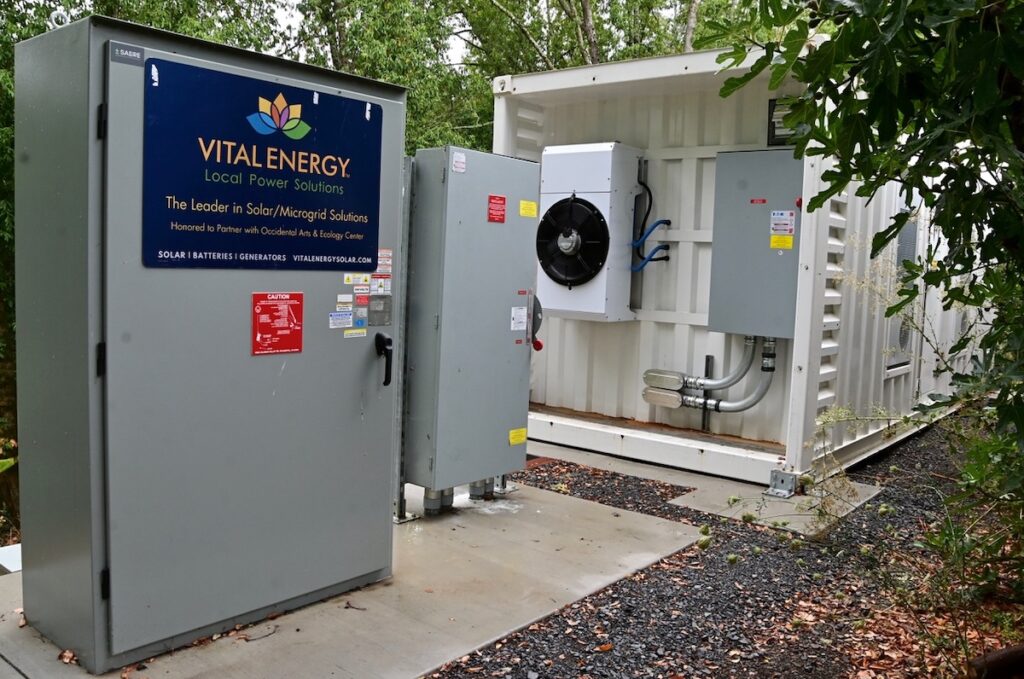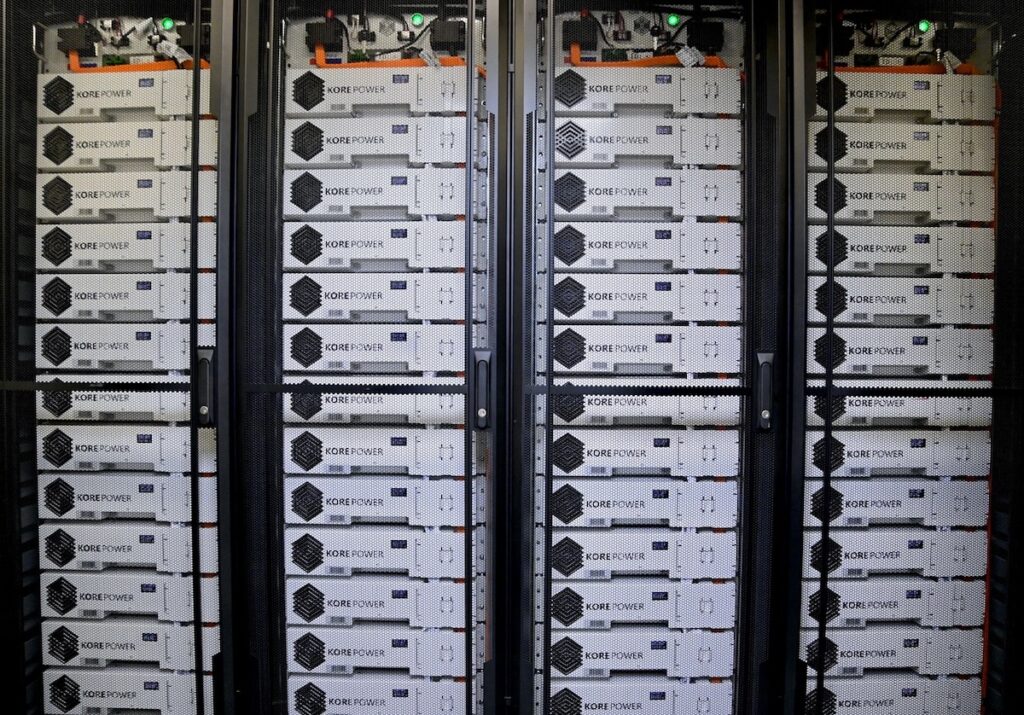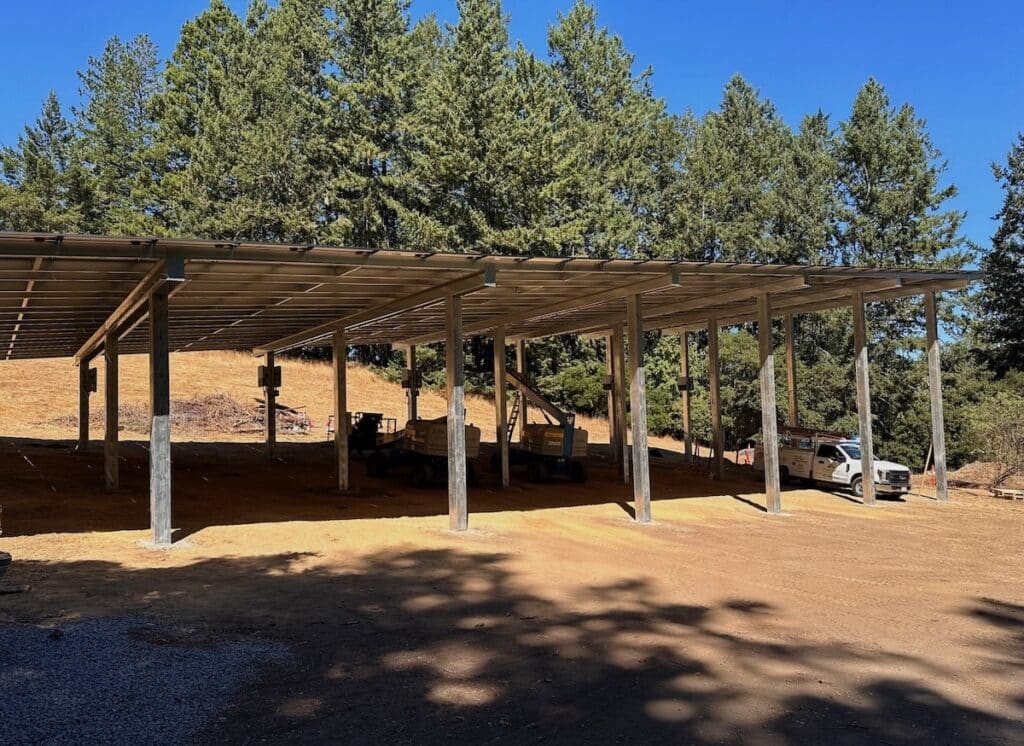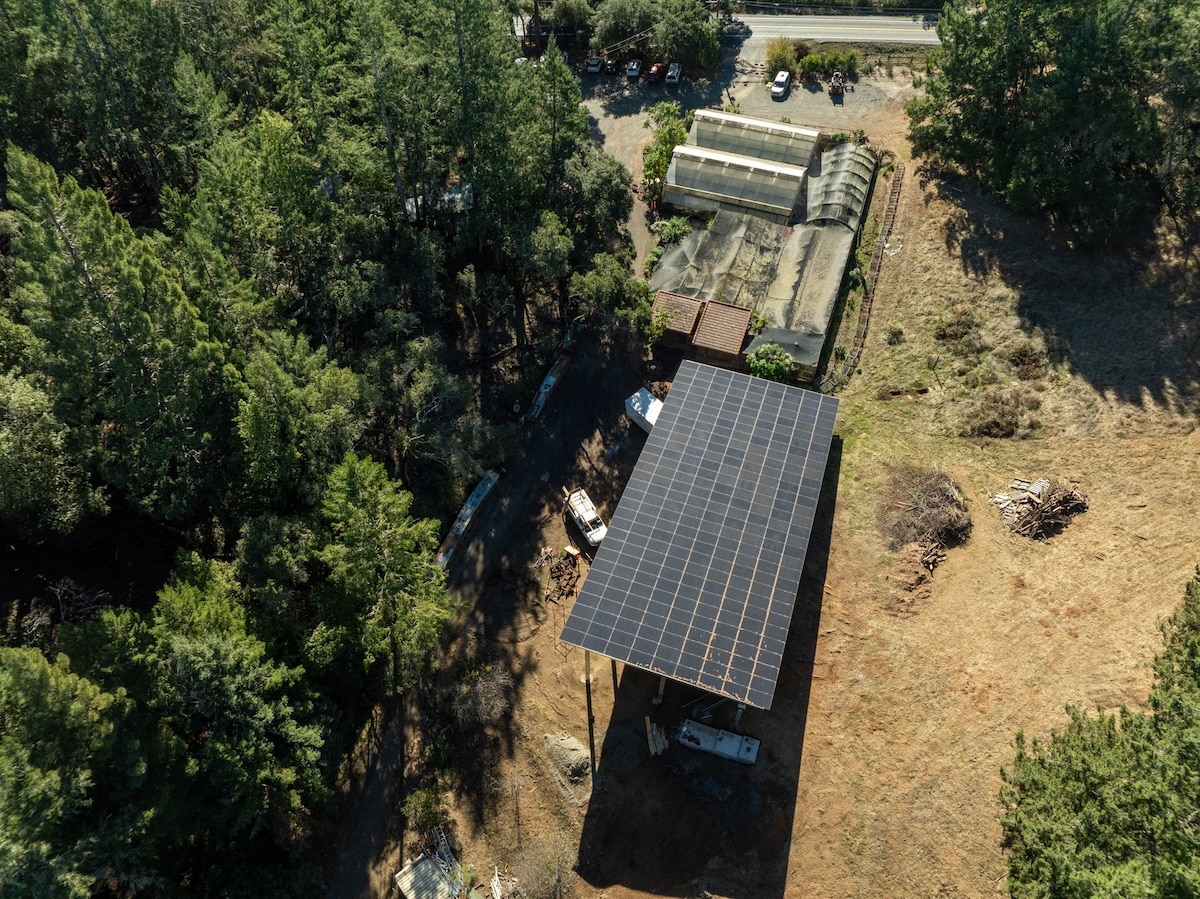By Dave Henson, OAEC Executive Director
In keeping with our work to create just and sustainable relationships with the land, each other, and future generations, the Occidental Arts & Ecology Center recently installed a photovoltaic solar and battery storage microgrid system at our site in partnership with RE-volv and Vital Energy Solutions.
We conducted a deliberative process to come to the decision to invest in an on-site solar and battery microgrid system to power the Center and the residential intentional community OAEC shares land and life with, the Sowing Circle. One of the things that we do at OAEC is to deeply consider the “full cost accounting” associated with any significant purchase, installation, or development. That means assessing not just the “price” of a project (i.e., how much money it will cost us), but, as importantly, assessing the true environmental and social costs of the project that are not included in that monetary price. These costs often include negative impacts to ecosystems and community health in the places where the extraction, production, transportation, and end-of-life disposal occur for each of the material elements of a project. These “externalities” are often not included in the price of any item or project, be it a small appliance or a large building.
In comparing the full cost of continuing to use electricity provided through the northern California electricity producer Pacific Gas and Electric (PG&E) (via the California electricity grid, where power is produced by many oil, gas, coal, nuclear, hydro, solar and wind power electricity sources across the state and western region) with creating our own electricity (through an on-site micro-grid solar production and lithium battery storage system), we concluded that in the aggregate, over the ~25 year lifespan of the system, investing in our new microgrid will yield cleaner and cheaper power for us, and do so with much less negative impact to ecosystems and community health along the supply, use, and disposal chains embedded in the electricity’s production.
We’ve been working on needs assessment, planning, permitting, engineering, financing, and construction since late 2022. Now that it’s up and running (mid 2025), we want to share the thinking behind the project: the ecological impact, energy security benefits, and economic case for this major investment in energy resilience.

What We Built
The microgrid solar and battery infrastructure cost us about $1.85 million. That includes:
- 124 kW solar array of 270 solar panels over an area of 6,000 sq ft, with the panels elevated above ground a minimum of 9’ to allow event parking beneath the panels (~$450,000)
- A 540 kWh (total energy storage capacity), 144 kW (maximum power the system can deliver at peak use) lithium-ion battery storage system, with six Kore Power 90kWh battery racks (~$820,000)
- 5 new large transformers
- 8 Sunny Boy TL-US-12 inverters
- 6 Enel X 9.6kW JuiceBox 40 EV Auto Chargers
- Major site work to run underground the high and low voltage lines between the solar array (which is in the big meadow by our Upper Nursery) and the battery system, which is in the Core Area of our Center and community, and to unify into one electrical system what had been four separate meters with PG&E.
This microgrid system will supply all the electricity needs for OAEC and our partner organization, the Sowing Circle intentional community, and we will be able to sell excess energy we produce to PG&E through our intertie with the regional electrical grid.
Sebastopol-based Vital Energy Solutions, serving the northern San Francisco Bay Area since 1971, led the design, engineering, procurement, and construction of the microgrid system with support from the OAEC construction crew. The project was partially financed through San Francisco-based RE-volv, a nonprofit that helps fellow nonprofits nationwide go solar by providing access to clean energy financing. We are grateful to both Vital Energy Solutions and RE-volv for their deep knowledge, professionalism, and commitment to the same values as OAEC. We particularly want to express our appreciation for Akshay Pagare, who led the project conception and design at Vital Energy. Akshay, a young electrical engineer student who grew up in our OAEC’s hometown of Occidental, approached us with his analysis and proposal, worked with us to come up with the big plan, and maintained an unwavering passion for and commitment to the project until completion.

Ecological Considerations
Of course, the best solution to energy production and use is to use less! We have put a lot of thought and practice over the past three decades into lowering our electrical consumption at every point of use at the Center and in our community.
As for why we chose the solar-battery microgrid system, at face value, solar energy is clean, renewable, and non-polluting at the point of use, eliminating the greenhouse gas (GHG) emissions associated with grid electricity, where many power plants still rely on fossil fuels.
But the story is more complicated than that. Photovoltaic solar panels, largely manufactured in China, contain dozens of materials, including rare earth minerals, plastics, metals, and glass. The extraction of these materials, often from countries and regions with lax human rights and environmental protections, carries significant externalized costs: immense water usage, increased toxicity in local air, surface water, and groundwater quality, greenhouse gas emissions, and the displacement and exploitation of local indigenous and low-income communities. These are all “externalized costs” that the users of “clean” solar panels will not see in their direct experience with solar electricity production.
Regarding the battery system, the ecological and social impacts of lithium-ion batteries are still unfolding. The lithium-ion batteries in our new system are made with NMC chemistry (nickel, manganese, and cobalt). These minerals have to be extracted, refined, and made into battery components — often in a dozen or more facilities each doing a part of the process — and also often under deeply exploitative and environmentally destructive conditions in many different parts of the world. There are geopolitical costs, too. Wars are being fought, in part, over mineral access. Russia’s invasion of the Donbas region is in part to claim Ukraine’s vast lithium mines and reserves there, and the wars that have ravaged the Congo for over 40 years are largely driven by fights to access the world’s largest deposits of cobalt.
Then there are end-of-life concerns. Lithium batteries are currently difficult to recycle, and lithium battery fires — like the massive one that raged in Moss Landing, CA, in January of 2025 at the Vistra Energy battery storage facility (one of the largest such plants in the world) — release many toxins into the air and water and are very hard to extinguish.
And yet, we chose to invest in a lithium-ion battery system because it’s the only viable storage technology at scale today for what we could possibly economically afford. Others are on the horizon — such as solid-state batteries that enhance safety and energy density, vanadium flow, graphene, lithium-sulfur, hydrogen, and metal-air batteries — but they’re not ready for commercial deployment. In the meantime, battery recycling is improving, and manufacturers now guarantee 15 years of usable life, with quickly developing pathways for reuse and reclamation.
We believe this system, with all its contradictions, is still a better ecological choice than relying on centralized grid power — much of which is fossil fuel-produced. By generating our own power, we contribute to better water quality, air quality, and reduced greenhouse gas emissions, both locally and across California, and lessen our collective negative impact on the environment and human rights in communities all over the world.

Energy Security
The OAEC campus — including eight homes, retreat lodging for 30 people, a full kitchen and dining hall, and more than 30 buildings — relies heavily on uninterrupted power. Freezers, refrigerators, water pumps, septic systems, heating and cooling, lighting, and A/V systems are all electric. We have intentionally moved away from propane or wood stoves for heating buildings, as the former is a fossil fuel with an enormous ecological footprint, and the latter contributes to less healthy air quality and is appropriately discouraged by our regional Air Quality District, when a home dweller or business can use another, less polluting source than wood stoves.
As OAEC hosts social and environmental change retreats and courses year-round, we need secure electricity to function. This isn’t hypothetical. PG&E outages are now a regular occurrence, especially in our rural part of Sonoma County. In the past, we patched through power outages with gasoline generators and extension cords. But that solution no longer works at scale, and it doesn’t align with our ecological values.
Moreover, PG&E has become increasingly cautious since being found liable for several major wildfires for not having maintained some of its power lines. Even a small wind-triggered sensor event can lead to multi-day preventative shutdowns across vast areas while power lines are being inspected. We used to be without power a week or two every winter, but now, summer outages are just as common. Because OAEC is in a rural area of our county and toward the “end of the line” in terms of the number of PG&E customers in our area, we’re often the last to have power restored when there is a significant outage.
The new system fixes this. When the grid goes down, our battery kicks in seamlessly, without interruption or brownout. Guests don’t notice. Retreats stay on track. In the past month alone, Occidental experienced three PG&E outages, none of which have affected our operations.
Regional Resilience
Another positive of investing in this system is that we’re not just powering ourselves; we’re also feeding energy back to the regional grid. Through California’s Self-Generation Incentive Program (SGIP), the state awarded us a $450,000 subsidy for installing battery storage. This is one of two major subsidies that made the system possible (more on that below), and it only applies when you include battery storage and a system that ties into the grid.
This significant financial incentive highlights the state’s interest in supporting distributed energy generation, reducing the need for new large-scale power plants, and increasing overall grid resilience. Every small producer — every school, business, retreat center — who can take themselves largely or fully off the grid (and even produce surplus for the grid) helps reduce the need to build new power plants. Local microgrids like ours make the entire system, in a small but additive way, more robust.
The Economics
Here’s the math.
The system cost about $1.85 million, but we received in subsidy:
- $450,000 in a grant from California’s Self-Generation Incentive Program (SGIP) for installing a large battery storage system intertied with the grid.
- $550,000 from the federal Investment Tax Credit (ITC), a 30% federal credit on solar installations. The Biden administration’s Inflation Reduction Act (IRA) allowed, for the first time, Tribes, cities, and non-profits to benefit through direct payment (in that these entities do not pay income taxes and thus could not benefit previously from the tax credit)
With the subsidies applied, our actual cost was about $850,000. Adding in interest payments on our $750,000 loan (~$400,000 over 20 years), and an estimated future battery replacement around year 15, which we’re budgeting at $750,000, we estimate our total 25-year cost at about $2 million.
That $2 million is still far below what we’d pay PG&E. Over 25 years, we anticipate potentially saving millions of dollars.
- Before the microgrid, we’ve paid $60,000/year in electricity costs for our whole site.
- PG&E electricity prices have increased about 10% annually over the last 10 years.
- If that 10% per year annual increase were to continue each year over 25 years (the panels have a 25-year warranty), we’d spend $5.9 million on electricity over 25 years.
- If we more conservatively predict a reduced annual increase in the cost of electricity (than over the past 10 years), with an increase of only 6% annually, we’d spend about $3.3 million.
Depending on how energy prices trend, we estimate the following savings on electricity costs over 25 years:
- We’d save $3.8 million over 25 years (assuming a 10% annual increase in PG&E costs – the same annual rate of increase as the past decade = $5.9 million minus $2.1 million)
- We’d save $1.2 million over 25 years (more conservatively assuming a 6% annual increase in PG&E costs = $3.3 million minus $2.1 million)
Deciding to do this project wasn’t just about economics, though it makes great financial sense. And it wasn’t just about energy security or ecological integrity. It was all of the above. We see this solar + storage system as an expression of our values and our emphasis on taking responsibility for our choices by doing full cost accounting to reveal externalized environmental and human costs. It’s not a perfect system, and it still relies on extractive systems, but our solar and battery microgrid system is an investment in a more resilient, sustainable future for OAEC and our community, and we feel good about making this choice!
Watch the video to see more.







